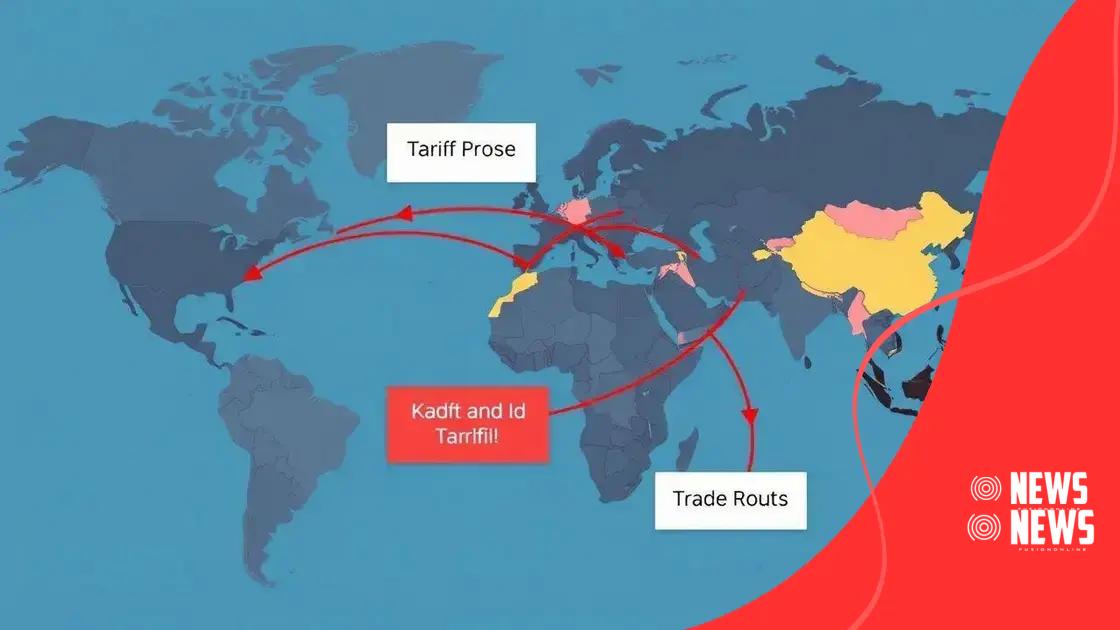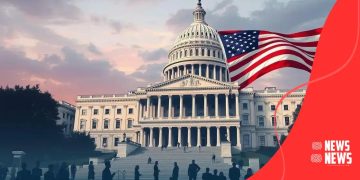Trump tariff policy: how it affects the economy
The Trump tariff policy significantly affected the economy by raising consumer prices, causing job shifts in various sectors, and altering international trade relations as countries sought new agreements in response.
Trump tariff policy has stirred significant debate over its effects on the economy. Many are left wondering how these tariffs truly impact prices and jobs. Let’s delve into the details and uncover the real story.
Overview of Trump tariff policy
The Trump tariff policy aimed to reshape trade practices. By imposing tariffs on certain goods, the administration intended to protect American jobs and boost domestic manufacturing. This approach sparked various debates regarding its long-term effectiveness and consequences.
What Are Tariffs?
Tariffs are essentially taxes imposed on imported goods. These taxes can lead to increased prices for consumers but are designed to protect local industries. How do they work? When a tariff is levied, the cost of foreign goods rises, encouraging consumers to choose domestic products instead.
Key Features of Trump’s Tariff Policy
Some of the key features included:
- Imposing tariffs primarily on steel and aluminum.
- Targeting specific countries such as China.
- Creating exemptions for certain allies.
These points illustrate the policy’s focus on specific sectors and countries, aiming to stimulate U.S. production. However, many wondered whether the benefits would outweigh the burdens, particularly regarding price increases.
Impact on Prices and Employment
The consequences of the Trump tariff policy were felt across various industries. Price hikes on imported goods meant that many products became more expensive for consumers. Additionally, while some domestic sectors saw job growth, others faced challenges due to higher operational costs. For instance:
- Consumers paid more for construction materials.
- Manufacturers faced increased input costs.
- The agriculture sector reported a decline in exports due to retaliatory tariffs.
Understanding these impacts remains critical as they shape both the economy and consumer behavior. As these policies evolve over time, so do their implications for global and domestic markets.
In summary, the Trump tariff policy significantly influenced trade dynamics. By balancing protectionism with international relationships, the administration sought to create a favorable environment for American businesses. The ongoing effects of these tariffs will undoubtedly continue to be a topic of discussion, making it essential to stay informed.
Key sectors impacted by tariffs
The Trump tariff policy impacted several key sectors across the American economy. Understanding which industries were affected can help us see the broader implications of these tariffs.
Manufacturing Sector
One of the most significant areas affected is manufacturing. Tariffs on steel and aluminum have reshaped cost structures for many companies. By raising the price of imported materials, the policy aimed to encourage domestic production.
- Increased costs for manufacturers using these metals.
- Encouraged some companies to source materials locally.
- Job creation within the domestic manufacturing sphere.
However, the increased costs also led to complications. Some manufacturers reported higher prices, which they had to pass onto consumers.
Agriculture and Exports
Another crucial sector impacted by the Trump tariff policy is agriculture. Farmers have faced challenges due to retaliatory tariffs from other countries. For example, China imposed tariffs on U.S. agricultural goods, affecting exports drastically.
- Lower demand for American soybeans and pork.
- Farmers struggling with reduced income.
- Need for new markets to compensate for lost sales.
The ripple effects of these tariffs highlight how interconnected global trade is and the vulnerabilities it creates for certain industries. Following these changes, many in agriculture sought alternatives in their trading relationships.
Retail Sector
Retailers also felt the impact of these tariffs, particularly on consumer goods. With increased prices, stores had to adjust their pricing strategies. Many consumers began to notice a rise in prices for everyday items such as electronics and clothing.
- Shifts in shopper behavior due to higher prices.
- Retailers exploring cost-cutting measures.
- Potential decline in consumer spending.
This sector must navigate the balance between maintaining margins and attracting price-sensitive consumers. The Trump tariff policy has certainly influenced the landscape in retail, forcing retailers to adapt rapidly.
As each sector adjusts to these changes, the long-term effects will remain to be seen. Observing how these key sectors respond provides crucial insights into the economic shifts driven by the tariffs.
Effects on international relations

The Trump tariff policy has had a profound impact on international relations. By imposing tariffs, the U.S. not only affected its own economy but also changed how countries interact with one another.
Trade Tensions
One immediate effect was the rise of trade tensions. Countries that were targeted by tariffs responded with their own measures. This back-and-forth created an atmosphere of uncertainty in global trade.
- Retaliatory tariffs from countries like China and Canada.
- Increased diplomatic challenges.
- Potential trade wars affecting global markets.
Such dynamics have strained relationships between the U.S. and its trading partners, complicating negotiations on other fronts.
Shifts in Alliances
Another notable consequence is the shift in alliances. Nations impacted by tariffs have sought to strengthen ties with other countries. For example, countries affected by U.S. tariffs might consider forming new trade agreements among themselves.
- Increased cooperation among the EU and Asia-Pacific nations.
- Efforts to reduce dependency on U.S. imports.
- Emergence of new trade partnerships, such as globalization trends.
This transition has the potential to realign global trade networks, affecting decisions made in marketplaces worldwide.
Long-Term Global Impact
Over time, the enduring effects of the Trump tariff policy could reshape the global economy. Nations may become more protective of their own industries. This protectionism can limit free trade and encourage countries to adopt similar tariff measures.
As a result, the landscape of international commerce and cooperation is shifting. Trade relationships that were stable may now be in flux, making observers question the long-term sustainability of previous agreements.
Continued monitoring of these international relations is necessary to understand the broader implications of tariffs and their effects on trade flows.
Domestic economic changes
The Trump tariff policy has led to notable changes in the domestic economy. As tariffs were imposed, various economic factors began to shift in response, affecting both businesses and consumers.
Changes in Consumer Prices
One immediate impact of tariffs was the increase in consumer prices. Imports became more expensive, leading to higher costs for everyday goods. This adjustment affected various markets as manufacturers passed costs onto consumers.
- Electronics prices surged due to higher tariffs on components.
- Clothing costs rose as textiles incurred additional tariffs.
- Household goods experienced notable price hikes.
Consumers started feeling the pinch as they had to pay more for essential products, affecting their purchasing decisions.
Job Market Adjustments
Another significant change came in the job market. While some sectors experienced job growth due to tariff protection, others faced decline. Industries like steel and aluminum saw boosts, but many agriculture and manufacturing jobs suffered.
- Job creation in protected sectors.
- Layoffs in export-oriented industries.
- Workers needing to adapt to new market demands.
This dynamic created a mixed job landscape, prompting discussions about the overall health of the economy.
Investment Shifts
Investment patterns also shifted as companies re-evaluated their strategies in light of the Trump tariff policy. Some businesses began to invest more domestically, while others considered moving operations abroad to avoid higher costs.
This led to a tension-filled environment where companies had to navigate complex trade regulations. Investors watched closely to gauge the long-term impacts on returns and profitability.
Overall, the domestic economic changes resulting from tariffs highlight the interconnectedness of global trade and local markets. As these adjustments continue to unfold, their effects will be critical for understanding the future economic landscape in the United States.
Future implications for trade
The Trump tariff policy has significant future implications for trade. As nations react to trade dynamics, the landscape of global commerce is expected to evolve.
Changing Trade Agreements
One major implication is the potential for changing trade agreements. Countries may feel encouraged to negotiate new deals that better protect their interests. This shift can lead to a reevaluation of existing agreements.
- Possibility of more regional trade agreements.
- Countries seeking to diversify trading partners.
- Emergence of new trade blocs to counterbalance tariffs.
As nations adapt to the tariff environment, collaboration may become essential to ensure economic stability.
Impact on Global Supply Chains
Another area to watch is global supply chains. Tariffs affect the cost of goods, and companies may seek alternative sources for materials and products. This could redefine supply chain strategies.
- Diversifying suppliers to mitigate risks.
- Increasing domestic production to reduce reliance on imports.
- Investing in technology to streamline supply operations.
These adjustments may enhance resilience against future economic shocks.
Long-Term Economic Relationships
Long-term economic relationships will also change based on how countries respond to the Trump tariff policy. Trust between nations can fluctuate, affecting future negotiations and collaborations. Nations may emphasize trade relationships that prioritize mutual benefits over punitive measures.
As businesses and governments navigate these complex interactions, the future of trade will depend on flexibility and cooperation. Ongoing monitoring of these changes will offer valuable insights into global economic health.
The Trump tariff policy has created a ripple effect through various sectors of the economy. As we have observed, it has reshaped domestic industry, influenced international relations, and adjusted consumer pricing. Companies are learning to adapt to these changes with new strategies and partnerships. The future of trade will be defined by how nations respond and cooperate. Staying informed about these developments is crucial for understanding the evolving economic landscape.
\n\n
\n
FAQ – Frequently Asked Questions about Trump Tariff Policy
What are the key impacts of the Trump tariff policy on the economy?
The Trump tariff policy has affected consumer prices, job markets, and international trade relationships.
How have tariffs influenced global trade relations?
Tariffs have increased trade tensions and led countries to seek new trade agreements, reshaping economic partnerships.
What sectors experienced growth due to the tariff policy?
The manufacturing sector, particularly steel and aluminum, saw job growth as a result of protective tariffs.
How can businesses adapt to changes brought by tariffs?
Businesses can diversify their supply chains, adjust pricing strategies, and explore new markets to remain competitive.





